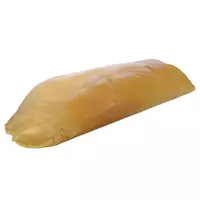Pâté foix gras

Recently, disputes have not subsided around the famous French delicacy of Foix Gras pâté. Animal advocates say that Foix Gras pate is a barbaric dish for which people brutally torment and then kill geese. Foodies and connoisseurs are ready to put up with such a price for the magnificent taste and subtle aroma of a goose liver pate called Foix Gras. The Foie Gras pate received its original name thanks to the phrase foie gras, which literally means "fatty liver" in French.
Goose liver pate is considered the national dish of France, so it is not surprising that this country occupies a leading position in the production and supply of the product to the world market. However, currently delicatessen Foie Gras is produced in the United States, China, Morocco, Hungary and Bulgaria. In some European countries, for example, in Germany, Poland, Italy and Luxembourg, as well as in Turkey, Croatia, the Czech Republic and Turkey, a ban on the production and sale of Foix Gras goose liver pate is legally enshrined.
Professionals claim that Foix Gras acquires its distinctive taste and aroma, as well as other consumer characteristics, exclusively as a result of a special product production technique. In order to prepare Foie Gras pate according to the classic recipe, you need to use the liver of a specially fed goose. However, in modern times, only a few percent of the composition of Foix Gras is in the goose liver. In most cases, the pate is made from the liver of a specially bred variety of ducks called mulards.
Poultry fattening for further production from the liver of Foix Gras pate is grown and fattened in a special way. For the first four weeks, ducklings feed, as usual and grow steadily. Then four weeks of grown geese or ducks are kept in isolated and small cages in order to limit the ability of birds to move. At that ducks or geese are fed with food saturated with protein and starch. Birds literally begin to "rip" from such a diet and lifestyle. From the tenth week of life, the bird begins to be forcibly fed.
This method is called gavage or gavage. Every day, the bird must eat at least
1. 8 kg of grain. Foie gras is distinguished not only by its excellent taste, but also by its vitamin-mineral composition, which is simply replete with vitamins and healthy substances. However, the main benefit of Foie Gras pate for human health lies in the content of a colossal amount of fatty polyunsaturated acids in the chemical composition of the food.
Some researchers and doctors believe that eating Foix Gras pate every day has a positive effect on the human body as a whole and helps prolong life. A sufficient number of centenarians among the population of southwestern France may speak of some veracity of such statements, where for several centuries goose liver pates have continued to be included in the daily diet.
pâteta foie gras 462 kCal
Energy value of foie gras pate (Ratio of proteins, fats, carbohydrates - ju):
Proteins: 11.4 g (~ 46 kCal)
Fats: 43.84 g (~ 395 kCal)
Carbohydrates: 4.67 g (~ 19 kCal)
Energy ratio (b | y): 10% | 85% | 4%
 Español
Español Français
Français Português
Português Русский
Русский 简体中文
简体中文 繁體中文
繁體中文 日本語
日本語 한국어
한국어 العربية
العربية Türkçe
Türkçe Қазақ
Қазақ Deutsch
Deutsch Italiano
Italiano Українська
Українська
